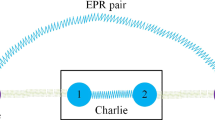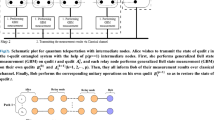Abstract
Introduction
In the future, quantum networks will be an important development direction. Quantum networks should be studied considering quantum's unique physical properties. In quantum networks with limited resources, decoherence will lead to qubits loss, which restricts the time that data qubits can be stored in memory before use. To realize the network function, it is very important to transmit data qubits as quickly as possible. In order to ensure timeliness and make use of entanglement resources as much as possible, this paper proposes a concurrent multipath entanglement routing scheme based on segment routing for quantum hybrid networks.
Methods
In this scheme, centralized routing is used to calculate the “segments” of quantum relay path, and distributed routing is used to transmit control messages between the “segments”. The “concurrent” mechanism is fully adopted in classical messages passing, path nodes BSM (Bell State Measurement) execution and multipath shunt transmission.
Conclusion
This scheme has obvious advantages in multipath concurrent transmission, traffic diversion, reducing transmission time and providing redundancy.










Similar content being viewed by others
Data availability
The used and analyzed data during the present study are available from the corresponding author on reasonable request.
Change history
04 May 2023
A Correction to this paper has been published: https://doi.org/10.1007/s11128-023-03925-2
References
Wehner, S., Elkouss, D., Hanson, R.: Quantum internet: a vision for the road ahead. Science 362, 9288 (2018)
Denchev, V.S., Pandurangan, G.: Distributed quantum computing: A new frontier in distributed systems or science fiction? ACM SIGACT News 39(3), 77–95 (2008). https://doi.org/10.1145/1412700.1412718
Beals, R., Brierley, S., Gray, O., Harrow, A.W., Kutin, S., Linden, N., Shepherd, D., Stather, M.: Efficient distributed quantum computing. Proc. R. Soc. A Math. Phys. Eng. Sci. 469(2153), 20120686 (2013). https://doi.org/10.1098/rspa.2012.0686
Nickerson, N.H., Fitzsimons, J.F., Benjamin, S.C.: Freely scalable quantum technologies using cells of 5-to-50 qubits with very lossy and noisy photonic links. Phys. Rev. X 4, 041041 (2014)
Gisin, N., Thew, R.: Quantum communication. Nat. Photon. 1, 165–171 (2007)
Bennett, C.H., Brassard, G.: Quantum cryptography: Public key distribution and coin tossing. In Proceedings of the International Conference on Computers, Systems and Signal Processing. (1984)
Bradley, C.E., Randall, J., Abobeih, M.H., Berrevoets, R.C., Degen, M.J., Bakker, M.A., Markham, M., Twitchen, D.J., Taminiau, T.H.: A ten-qubit solid-state spin register with quantum memory up to one minute. Phys. Rev. X 9, 031045 (2019)
Kómár, P., et al.: A quantum network of clocks. Nat. Phys. 10, 582–587 (2014)
Kozlowski, W., Dahlberg, A., Wehner, S.: Designing a quantum network protocol. In Proceedings of the 16th International Conference on emerging Networking EXperiments and Technologies (CoNEXT '20). pp. 1–16. Association for Computing Machinery, New York, NY, USA. (2020) https://doi.org/10.1145/3386367.3431293.
Abobeih, M.H., Cramer, J., Bakker, M.A., Kalb, N., Markham, M., Twitchen, D.J., Taminiau, T.H.: One-second coherence for a single electron spin coupled to a multi-qubit nuclear-spin environment. Nat. Commun. 9(1), 1–8 (2018)
Bradley, C., Randall, J., Abobeih, M., Berrevoets, R., Degen, M., Bakker, M., Markham, M., Twitchen, D., Taminiau, T.: A ten-qubit solid-state spin register with quantum memory up to one minute. Phys. Rev. X 9(3), 031045 (2019)
Skrzypczyk, M., Wehner, S.: An architecture for meeting quality-of-service requirements in multi-user quantum networks. (2021). arXiv: 2111.13124
Fowler, A., Wang, D.S., Hill, C.D., Ladd, T.D., VanMeter, R., Hollenberg, L.C.L.: Surface code quantum communication. Phys. Rev. Lett. 104(18), 180503 (2010)
Munro, W.J., Stephens, A.M., Devitt, S.J., Harrison, K.A., Nemoto, K.: Quantum communication without the necessity of quantum memories. Nat. Photon. 6(11), 777 (2012)
Muralidharan, S., Kim, J., Lütkenhaus, N., Lukin, M.D., Jiang, L.: Ultrafast and fault-tolerant quantum communication across long distances. Phys. Rev. Lett. 112(25), 250501 (2014)
Muralidharan, S., LinshuLi, J.K., NorbertLütkenhaus, M.L., Jiang, L.: Optimal architectures for long distance quantum communication. Sci. Rep. 6(2016), 20463 (2016)
Briegel, H.-J., Dür, W., Cirac, J.I., Zoller, P.: Quantum repeaters: the role of imperfect local operations in quantum communication. Phys. Rev. Lett. 81(26), 5932 (1998)
Bennett, C.H., Brassard, G., Crépeau, C., Jozsa, R., Peres, A., Wootters, W.K.: Teleporting an unknown quantum state via dual classical and Einstein-Podolsky-Rosen channels. Phys. Rev. Lett. 70, 1895–1899 (1993)
Shi, S., Qian, C.: Concurrent Entanglement Routing for Quantum Networks: Model and Designs. In Proceedings of the Annual conference of the ACM Special Interest Group on Data Communication on the Applications, Technologies, Architectures, and Protocols for Computer Communication. pp. 62–75. (2020)
Dahlberg, A., Skrzypczyk, M., Coopmans, T., Wubben, L., Rozpędek, F., Pompili, M., Stolk, A., Pawełczak, P., Knegjens, R., de Oliveira Filho, J., Hanson, R., Wehner, S.: A link layer protocol for quantum networks. In Proceedings of the ACM Special Interest Group on Data Communication (Beijing, China) (SIGCOMM ’19). pp. 159–173, ACM, New York, NY, USA. (2019)
Liu, Q., Wei, Y., Li, H., Xue, S., Jiang, M.: Quantum parallel teleportation of multi-qudit state via different paths. Eur. Phys. J. D (2021). https://doi.org/10.1140/epjd/s10053-021-00210-8
Khatri, S., Matyas, C.T., Siddiqui, A.U., Dowling, J.P.: Practical figures of merit and thresholds for entanglement distribution in quantum networks. Phys. Rev. Res. 1, 023032 (2019)
Caleffi, M.: Optimal routing for quantum networks. IEEE Access 5(2017), 22299–22312 (2017)
Chakraborty, K., Elkouss, D., Rijsman, B., Wehner, S.: Entanglement distribution in a quantum network: a multicommodity flow-based approach. IEEE Trans. Quantum Eng. 1, 1–21 (2020). https://doi.org/10.1109/TQE.2020.3028172
Zhang, L., Liu, Q.: Optimisation of the routing protocol for quantum wireless Ad Hoc network. IET Quantum Commun. 3(1), 5–12 (2021). https://doi.org/10.1049/qtc2.12028
Li, C., Li, T., Liu, Y.X., et al.: Effective routing design for remote entanglement generation on quantum networks. npj Quantum Inform. 7(1), 10 (2021)
Illiano, J., Caleffi, M., Manzalini, A., Cacciapuoti, A.S.: Quantum internet protocol stack: a comprehensive survey. arXiv: 2202.10894 (2022)
Leone, H., Miller, N. R., Singh, D., Langford, N.K., Rohde, P.P.: QuNet: Cost vector analysis & multipath entanglement routing in quantum networks. (2021)
Zhang, L., Ye, S.-X., Liu, Q., Chen, H.: Multipath concurrent entanglement routing in quantum networks based on virtual circuit. In 2022 4th International Conference on Advances in Computer Technology, Information Science and Communications (CTISC), pp. 1–5 (2022). https://doi.org/10.1109/CTISC54888.2022.9849807.
Xiong, P.Y., Yu, X.T., Zhang, Z.C., et al.: Routing protocol for wireless quantum multi-hop mesh backbone network based on partially entangled GHZ state. Front. Phys. 12, 187–196 (2017)
Pant, M., et al.: Routing entanglement in the quantum internet. npj Quantum Inform. (2019). https://doi.org/10.1038/s41534-019-0139-x
Huang, W., Jiang, D., Chen, L.: Concurrent efficient entanglement routing for quantum wireless networks. Phys. Rev. A (2022). https://doi.org/10.1103/PhysRevA.105.042619
Chakraborty, K., Rozpedek, F., Dahlberg, A., Wehner, S. : Distributed Routing in a Quantum Internet. (2019). arXiv:1907.11630[quant-ph].
Filsfils, C., Previdi, S., Ginsberg, L., Decraene, B., Litkowski, S., et al.: Segment Routing Architecture. RFC 8402, (2018). https://doi.org/10.17487/RFC8402
Filfils, C. et al.: Segment Routing Architecture, draft-filsfils-spring-segment-routing, Internet Draft, (2013)
Filfils, C. et al.: Segment Routing with MPLS data plane, draft-filsfils-spring-segment-routing, Internet Draft, (2013)
Nunes, B., Mendonca, M., Nguyen, X., et al.: A survey of software-defined networking: past, present, and future of programmable networks. IEEE Commun. Surv. Tutor. 16(3), 1617–1634 (2014)
Brassard, G., Bussieres, F., Godbout, N., Lacroix, S.: Multi-user quantum key distribution using wavelength division multiplexing. In: Proceedings of SPIE 5260. Applications of Photonic Technology vol 6, pp 149–153 (2003)
Filfils, C. et al.: Segment routing part II: traffic engineering. (2019)
Sidhu, J.S., Kok, P.: Geometric perspective on quantum parameter estimation. AVS Quantum Sci. 2, 014701 (2020)
Pompili, M., Hermans, S.L., Baier, S., Beukers, H.K., Humphreys, P.C., Schouten, R.N., Vermeulen, R.F., Tiggelman, M.J., dos Santos Martins, L., Dirkse, B., et al.: Realization of a multinode quantum network of remote solid-state qubits. Science 372(6539), 259–264 (2021)
Manzalini, A., et al.: End-to-end entanglement generation strategies: capacity bounds and impact on quantum key distribution. Quantum Rep. 4(3), 251–263 (2022)
Funding
This research was funded by Scientific Research Fund of Yunnan Provincial Education Department, China, Grant Number 2022J1084.
Author information
Authors and Affiliations
Contributions
LZ contributed to conceptualization and methodology; LZ contributed to writing—original draft preparation; QL contributed to resources; LZ and QL contributed to writing—review and editing; QL contributed to supervision; LZ contributed to funding acquisition. All authors have read and agreed to the published version of the manuscript.
Corresponding author
Ethics declarations
Conflict of interest
The authors declare no conflict of interest.
Additional information
Publisher's Note
Springer Nature remains neutral with regard to jurisdictional claims in published maps and institutional affiliations.
The original online version of this article was revised: The error in equation 3 and 4 in page 16 has been corrected.
Appendix A
Appendix A
1.1 Quantum entanglement multipath system
Figure
Schematic diagram of quantum entanglement multipath system. There are several quantum entanglement paths from the quantum source node A to the quantum destination node B. No matter how many quantum relay nodes are passed on the p-th path, the quantum path can always be changed into node A–X–B model at last due to entanglement swapping. Then, nodes A and X share a Bell pair of \({A}_{(p)}\),\({A}_{(p)}^{\mathrm{^{\prime}}}\), nodes B and X share a Bell pair of \({B}_{(p)}\), \({B}_{(p)}^{\mathrm{^{\prime}}}\). By performing BSM on node X, a remote end-to-end quantum entanglement path can be established between node A and node B. The other n–1 paths and so on
11 shows a schematic diagram of a quantum entanglement multipath system. There are several quantum entanglement paths from the quantum source node A to the quantum destination node B. The path in the middle is the p-th path. No matter how many quantum relay nodes are passed on the p-th path, the quantum path can always be changed into node A–X–B model at last due to entanglement swapping. Suppose the number of quantum paths from the source to the destination is n. According to the principle of quantum teleportation [18], on the P-th (p = 1,2… n) path, the system composed of Bell pairs \({A}_{(p)}\),\({A}_{(p)}^{^{\prime}}\) and \({B}_{(p)}\),\({B}_{(p)}^{^{\prime}}\) is expressed by formula (5).
Quantum relay node X performs BSM on \(A_{\left( p \right)}^{^{\prime}}\) and \(B_{\left( p \right)}^{^{\prime}}\), and the expression of the Bell bases is (6).
Therefore, formula (5) can be rewritten as formula (7).
For example, if \({|\psi \rangle }_{{A}_{\left(p\right)}^{^{\prime}}{B}_{\left(p\right)}^{^{\prime}}}^{-}\) is chosen, the state of particles \({A}_{(p)}\) and \({B}_{(p)}\) is \({|\psi \rangle }_{{A}_{\left(p\right)}{B}_{\left(p\right)}}^{+}\) after BSM, and entanglement is realized. An entangled quantum channel is successfully established between nodes A and B. Formula (5)–(7) are the derivation of the p-th path assuming that the quantum link bandwidth is 1 (only 1 data qubit can be transmitted). If each path quantum link bandwidth is k (k = 1,2… m), then the system composed of n paths is expressed by formula (8).
Rights and permissions
Springer Nature or its licensor (e.g. a society or other partner) holds exclusive rights to this article under a publishing agreement with the author(s) or other rightsholder(s); author self-archiving of the accepted manuscript version of this article is solely governed by the terms of such publishing agreement and applicable law.
About this article
Cite this article
Zhang, L., Liu, Q. Concurrent multipath quantum entanglement routing based on segment routing in quantum hybrid networks. Quantum Inf Process 22, 148 (2023). https://doi.org/10.1007/s11128-023-03891-9
Received:
Accepted:
Published:
DOI: https://doi.org/10.1007/s11128-023-03891-9





